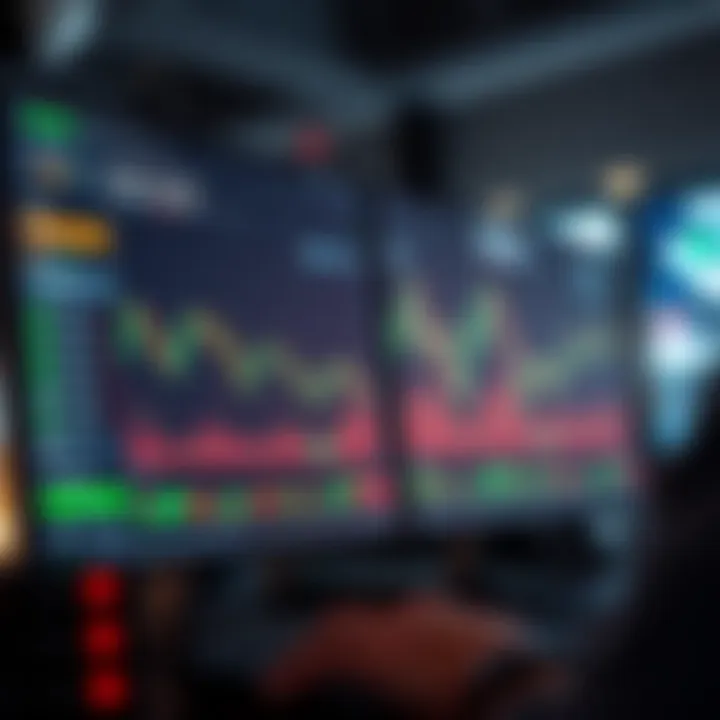In-Depth Analysis of Leading Trading Platforms


Intro
Selecting a trading platform is pivotal for any investor, whether you are just dipping your toes or you're an old hand in the game. In this digital age, where options overflow, understanding the nuances between platforms becomes essential. This article will walk you through a detailed evaluation of the top trading platforms. We will cover their unique features and user experiences while also focusing on security measures and overall performance. You'll gain insights into market trends and the specific advantages and drawbacks of each platform, arming you with the knowledge needed to make informed decisions that align with your investment goals.
As the landscape of trading continues to evolve, the platforms available to users are also transforming rapidly. Knowing how to navigate these options can be the difference between a successful trading experience and a costly misstep. Therefore, our mission here is to provide clarity amid the growing complexity. Let's start by clarifying some key terms that are crucial for understanding the trading world.
Foreword to Trading Platforms
In the intricate world of finance, trading platforms serve as the bridge between individual investors and the vast markets that shape our economic landscape. Understanding what a trading platform is, and its significance helps demystify investing for many. The right trading platform can empower investors, providing them with the tools and insights necessary to make informed decisions and leverage opportunities effectively.
When navigating through various platforms, one realizes that not all of them are created equal. Each platform comes with its unique set of features, fees, and user experiences, making the process of evaluating them both critical and nuanced. The selection of an appropriate platform is often influenced by factors including the investor's level of expertise, investment goals, and the types of assets being traded. As a result, the importance of evaluating trading platforms lies not just in personal comfort, but in understanding how well each platform caters to specific trading needs.
Definition and Importance
A trading platform is essentially the software tool that investors use to buy and sell securities like stocks, bonds, and cryptocurrencies. The advent of technology has transformed these platforms from mere transaction facilitators to comprehensive ecosystems that support various aspects of trading, from market analysis to portfolio management. The significance of trading platforms can't be understated; they are the core of any trading activity. Choosing the right one can mean the difference between achieving profitable trades and incurring losses due to inefficiencies.
In the age of information, where split-second decisions can shape fortunes, the functionality and reliability of a trading platform becomes paramount. Factors such as speed, ease of use, and access to market data all contribute to the overall effectiveness of the platform. It's not just about executing a trade anymore; it's about having the right tools at one’s disposal to analyze and manipulate the market effectively.
Types of Trading Platforms
When selecting a trading platform, understanding the different types available can significantly influence one’s investment journey. There are generally three categories to consider:
- Web-based Platforms:
These are accessed through internet browsers, which means they can be used on any device that has internet connectivity. They often come with lower fees but may lack some advanced features found in desktop versions. - Desktop Platforms:
These are downloaded and installed on personal computers. Desktop platforms tend to offer more sophisticated trading tools and greater customization, making them suitable for serious traders who rely on advanced features for technical analysis. - Mobile Platforms:
With the rise of smartphones, many trading platforms now offer mobile apps. These allow for trading on-the-go, providing convenience and flexibility. While they may not offer all the features of their desktop counterparts, they cater to the needs of investors looking for accessibility.
"Choosing the right type of trading platform is crucial for aligning with one's investment strategy and personal preferences."
Key Features of Trading Platforms
Evaluating trading platforms involves a careful examination of key features that contribute to user satisfaction and overall performance. When diving into the realm of trading, understanding these features ensures that seasoned traders and novices alike can select a platform that aligns with their goals. Consideration of features can either enhance trading experience or lead to frustration and inefficiency. Here are some elements that deserve attention:
User Interface and Experience
The user interface (UI) and user experience (UX) are vital to how traders interact with a platform. A clean and navigable layout often makes all the difference.
- Intuitive Design: When traders can easily find tools and information, it enables more efficient decision-making. Intuitive designs can reduce the learning curve and allow users to execute trades without delay.
- Visual Aids: Charts, graphs, and other visual tools assist in data interpretation. A well-designed platform integrates these visual aids seamlessly within the interface, giving traders a clearer picture of market movements.
- Accessibility: With a growing trend towards mobile trading, having a robust mobile interface is increasingly essential. Platforms that offer fully-featured apps tend to attract more users.
"A sleek interface isn’t just fluff; it’s the backbone of effective trading."
Trading Tools and Resources
Having the right tools can make or break a trading experience. Traders often rely on various features to assist in their decision-making and risk management.
- Analytical Tools: These include technical indicators, indicators like moving averages, or Fibonacci retracement tools. The presence and quality of these tools can greatly influence trading strategies.
- Market News and Updates: Real-time news feeds integrated into the platform help traders stay informed. Platforms that offer timely updates on events like earnings reports, geopolitical developments, or economic data releases provide a substantial edge.
- Paper Trading Options: Many platforms offer demo accounts for users to practice trading without risking capital. This feature is crucial for beginners and can help develop confidence before entering live markets.
Customization and Flexibility
In a world where personal preferences are king, the ability to customize a trading platform is key. Different traders have different styles, and a platform that accommodates these variances can stand out.
- Personalizable Dashboards: Flexibility to arrange charts, news feeds, and other widgets in a way that suits individual workflows can enhance productivity. Users might prefer a clean design while others might want everything at their fingertips.
- API Access: For the tech-savvy, some platforms provide API access for automated trading. This allows users to create custom trading applications tailored to their strategies.
- Variety of Assets: A trading platform that provides different types of assets—stocks, ETFs, cryptocurrencies—grants users the freedom to explore diverse investment strategies.
In summary, assessing the features of trading platforms is more than just an exercise in preference. It's about finding the right tools and interfaces that can enhance the trading experience, leading to better decision-making and potentially increased returns.
A well-designed platform can support a trader’s journey, whether they are just starting or refining established strategies, by providing the necessary attributes that allow them to thrive.
Security and Reliability
In the realm of trading platforms, security and reliability stand as the twin pillars that uphold users’ trust and confidence. As investments increasingly transition into digital spaces, the potential risks—all from data breaches to system downtimes—can wreak havoc on traders’ financial stability and peace of mind. Thus, understanding the intricacies of a platform's security measures and its reliability is paramount.
Platforms that prioritize robust security protocols not only protect user information but also enhance overall user experience. Moreover, demonstrating reliability, through consistent uptime and responsive customer support, paves the way for informed trading decisions, enabling investors to operate without the nagging fear of unforeseen disruptions or compromises in safety.
Data Protection Measures
Data protection in trading platforms consists of the frameworks and technologies that safeguard sensitive user information from unauthorized access or malicious intent. At the heart of effective data protection lies encryption. When data travels over the internet, it should be encrypted, ensuring that even if intercepted, the information remains unreadable. For instance, top platforms like Binance or E*TRADE employ advanced Secure Socket Layer (SSL) encryption to encrypt user communications.
Additionally, two-factor authentication (2FA) is becoming an industry standard, enhancing protection by adding a second layer of security. This may involve a text message code being sent to the user’s mobile device every time they access their account, thus making it much harder for hackers to breach accounts, even if they manage to capture passwords.
Moreover, regular security audits and vulnerability assessments can further fortify platforms against emerging threats. Companies frequently update their software components to patch vulnerabilities, helping to thwart potential exploitation and protect users more effectively.
Regulatory Compliance
Navigating the labyrinth of regulations is essential for trading platforms to foster user trust and legitimacy. Compliance with local and international regulations ensures that platforms maintain transparency and uphold strong ethical standards. Many platforms operate under the auspices of regulators such as the Financial Industry Regulatory Authority (FINRA) or the Securities and Exchange Commission (SEC) in the U.S., which impose strict guidelines on trading practices and data handling.


For instance, regulated platforms are obligated to keep client funds in segregated accounts, which protects users’ investments in the event of financial troubles. Not complying with these regulations can not only tarnish a platform’s reputation but can also lead to severe financial penalties. Thus, it’s critical to choose a trading platform that adheres to rigorous regulatory standards to ensure both safety and accountability.
User Feedback on Security
User feedback acts as a valuable compass when assessing security measures of trading platforms. Real users provide firsthand accounts of their experiences—both positive and negative—offering insights into a platform's reliability. Before diving into a platform, potential users should scour forums like Reddit and dedicated finance communities to gather insights.
Feedback often highlights key factors such as the effectiveness of customer support when security issues arise. Are users receiving timely assistance? Is there a responsive channel for reporting suspicious activity? On platforms like Robinhood or TD Ameritrade, users often share their security issues and how effectively the platform managed them.
Moreover, monitoring community discussions and testimonials can help investors gauge actual experiences over marketing fluff. As the saying goes, “the proof is in the pudding”—it’s crucial to look beyond the surface and delve deeper into actual user experiences when considering where to put one’s hard-earned money.
Cost Structures of Trading Platforms
Understanding the cost structures associated with trading platforms is vital for any investor looking to maximize their returns. All trading platforms come as unique packages with distinct pricing components. While some costs are upfront, like commissions and fees, others can sneak up on unsuspecting investors, dampening their overall investment performance. By becoming savvy about these costs, investors can avoid unnecessary fees and choose platforms that align with their trading behaviors and financial goals.
Commission Fees and Spreads
Commission fees represent a direct cost incurred when executing trades. These fees can vary dramatically between platforms, and understanding them is crucial. Some platforms charge a fixed fee per trade, while others apply a percentage of the total trade value. For instance, a platform might charge $5 per trade, while another might take 0.5% of the trade value. Here is why it matters:
- Cost Efficiency: Higher commissions can erode profits, particularly for frequent traders. A trader who executes multiple trades daily might find themselves paying substantial amounts in commissions, effectively eating into their gains.
- Spreads: A related but distinct cost is the spread, which is the difference between the buying and selling price of an asset. Some platforms advertise "zero commissions," but they often make money through wider spreads. A keen investor should evaluate whether the spread compensates for the absence of direct fees.
Consider calculating the total cost of trading by summing up both commissions and spreads—this gives a clearer picture of what’s at stake.
Account Minimums and Maintenance Fees
Account minimums and maintenance fees can take less attention, yet they're crucial in assessing the financial implications of a trading platform. Many trading platforms have minimum amount requirements to open an account, which can vary widely.
- Account Minimums: Some platforms only require a nominal fee to open an account, while others may demand thousands. If an investor is just starting or prefers to invest a modest amount, platforms with high minimums can be prohibitive. Just imagine being asked to part with a significant sum without even making a trade!
- Maintenance Fees: These fees can sneak up if not checked. Some platforms charge monthly or annual fees simply to keep the account active, and these can vary based on account balance. An investor with a low account balance might find these charges disproportionate, negating potential gains.
Properly evaluating the costs tied to account minimums and maintenance fees is essential.
"Not every trading platform has a clear pricing structure. Be vigilant and dig deep into the fine print to avoid unexpected charges."
Market Trends and Technologies
Understanding market trends and technologies is essential for anyone involved in trading, whether a seasoned investor or a novice just stepping into the financial arena. The evolution of trading platforms is closely tied to technological advancements, and as such, staying updated on these trends can lead to smarter trading decisions.
Importance of Market Trends and Technologies
Market trends refer to the general direction in which the market is moving. They can provide insights into the behavior of stocks, commodities, or other financial instruments. Technologies play a pivotal role as catalysts in this market movement. With new tech solutions, traders can now analyze data more efficiently, execute trades quicker, and gain insights that were previously inaccessible.
Several key points highlight the significance of monitoring these trends:
- Enhanced Decision Making: With improved analytical tools, investors can make informed choices that significantly impact their portfolios.
- Efficiency in Trading: Automation and algorithmic trading can carry out trades as fast as a blink of an eye, reducing the time taken to capitalize on market movements.
- Accessibility: Technology enables retail investors to access tools and information that were once only available to institutional traders.
Adapting to these trends is not just recommended; it’s imperative for staying competitive in today's fast-paced trading environment.
Impact of Technology on Trading
When it comes to the impact of technology on trading, one cannot overlook the wave of innovations that have reshaped the trading landscape. Online trading platforms have made it possible to buy and sell assets with unparalleled ease.
The incorporation of big data analytics offers traders insights into market trends that are otherwise hidden. Algorithms now run sophisticated analyses on vast datasets to predict market shifts and assist in decision-making. Let’s explore some notable impacts:
- Real-Time Data: Instant access to real-time data allows for timely decisions. For traders, this could mean the difference between profit and loss.
- Social Trading: Platforms now integrate social media aspects, enabling traders to follow each other’s strategies, which can be particularly beneficial for less experienced investors seeking guidance.
- Artificial Intelligence: AI-driven algorithms can analyze market patterns and execute trades autonomously, improving overall efficiency.
While these advancements hold tremendous potential, they also come with their own set of challenges, including reliance on technology that may fail or produce erroneous results.
Trends in Mobile Trading
In recent years, mobile trading has surged in popularity, driven by the inherent convenience of smartphones and tablets. The ability to manage investments on-the-go has revolutionized how people engage with markets.
Key trends include:
- User-Friendly Apps: Trading apps like Robinhood have simplified the trading process, making it accessible for users of all experience levels. The ease of use has drawn younger generations towards investing more than ever.
- Increased Connectivity: As global markets operate round the clock, mobile platforms allow for 24/7 trading, enabling users to react quickly to market changes.
- Security Enhancements: While mobile trading is convenient, security remains a critical concern. Many apps utilize biometric authentication and encryption protocols to protect user data.
Mobile trading is likely only to grow, with advancements in technology fostering even greater capabilities and security measures. Investors need to be aware of these trends and utilize mobile technologies to remain agile and informed.
In the fast-evolving world of trading, keeping pace with technological trends is not just an advantage; it’s a necessity.
Overall, the blend of market trends and technological advancements paints a vivid picture of the trading landscape. Investors who can harness these tools while navigating potential pitfalls stand better positioned for success.
Platform Comparisons


When it comes to selecting the right trading platform, comparison stands out as a critical step. Just like trying to find the best route on a map, evaluating various platforms can save investors ample time and money. Traders need platforms that not only resonate with their trading style but also cater to unique needs and preferences. In this section, we will delve into the elements that make comparisons essential, incorporating factors that every trader should keep in mind.
Features Comparison Chart
A features comparison chart serves as a vital tool for evaluating trading platforms. This chart simplifies the decision-making process by distilling an abundance of information into easily digestible data points. Traders can assess aspects like:
- User Interface: Some platforms may offer a sleek design but lack functionality, while others prioritize robust features over aesthetics.
- Available Assets: The choice of stocks, commodities, or cryptocurrencies can differ significantly across platforms. This diversity can affect a trader’s strategy and overall experience.
- Fees and Commissions: Understanding costs associated with trading is paramount. Some platforms may advertise low fees but hide charges in other areas. Therefore, clarity is essential.
- Support Services: Availability of customer support, including chat assistance or educational resources, can make a world of difference.
Having data laid out like this sheds light on what platforms bring to the table and helps demystify options that might initially appear similar. However, it’s important to note that one size doesn't fit all. Traders must reflect on which features matter most to them, ensuring they align with individual trading objectives.
Strengths and Weaknesses of Leading Platforms
Every trading platform comes with its own set of strengths and weaknesses. Understanding these can illuminate the best options suited for different types of investors.
Strengths
- Platform A: Known for its user-friendly interface and a vast range of tradable assets, Platform A is particularly attractive for beginners. The educational tools provided are top-notch, offering newcomers the chance to learn while they trade.
- Platform B: It excels in security measures, utilizing advanced encryption techniques. This is a key strength for traders who prioritize safety and data protection.
Weaknesses
- Platform A: Despite its beginner-friendly approach, it may lack advanced trading tools that experienced traders seek.
- Platform B: The user interface can be overwhelming for new users, making navigation a challenge.
By identifying specific strengths and weaknesses of each platform, traders can more effectively match their needs and preferences with the right tools. It’s not merely about the features, but how they complement a trader’s style.
"Understanding the strengths and weaknesses of a trading platform is like knowing the lay of the land before embarking on a journey; without this, making informed decisions becomes nearly impossible."
Choosing the Right Trading Platform
Choosing the right trading platform can make or break an investor's experience. This decision isn’t merely about looking for the flashiest interface or the lowest fees; it’s about finding a platform that aligns with your trading style, goals, and financial needs. An informed choice here can lead to increased efficiency, greater satisfaction, and ultimately, success in your trading endeavors.
To navigate the vast array of options available today, it's essential to pay attention to specific elements that cater to your individual requirements. Factors such as account types, the breadth of available assets, ease of use, support services, and educational resources become key pillars of evaluation. Investors must also weigh the advantages of features such as advanced charting tools, real-time market data, and automated trading capabilities.
Taking the time to research not only saves you from potential headaches down the road but can significantly enhance your trading journey. If you choose a platform that lacks important features, you may find yourself frustrated. Here are some crucial benefits to consider in your selection process:
- Cost-effectiveness: Different platforms have varying commission structures, which can impact your overall profitability.
- Support and Resources: Quality customer service and educational materials can be invaluable, especially for beginners.
- User Experience: Intuitive design and accessibility significantly affect how you interact with the platform.
With the stakes this high, having a checklist of considerations can be an investor’s best friend.
Assessing Individual Needs
Before settling on a platform, filter through your own trading habits and preferences. Are you a day trader needing fast execution and advanced tools? Or perhaps you prefer a long-term investment approach? Knowing the products you'll trade, whether stocks, options, or forex, is essential.
Additionally, assess your level of trading knowledge. While some platforms cater to the seasoned pro with numerous analytical tools, others may appeal more to newcomers, offering simplified interfaces and ample educational content. Identify elements that resonate with your investment strategy.
Some questions to ponder might include:
- What is your trading style?
- How often do you trade?
- What markets do you want to access?
- Do you require any additional tools for technical analysis?
- Is the platform mobile-friendly?
In sum, understanding these fundamental aspects enables you to select a platform that enhances your trading experience rather than complicating it.
Trial Periods and Demos
Many trading platforms now provide trial periods or demo accounts, giving investors a chance to walk the digital landscape before committing their hard-earned cash. These offerings are invaluable for gauging compatibility with a platform. They allow users to experiment with tools, explore features, and get a feel for the interface without financial risk.
In practice, during this trial period, you can engage with:
- Simulated trading environments: Practice placing trades without real money.
- Explore customer service: Test response times and the helpfulness of support staff.
- Assess educational resources: Verify if the platform truly meets your learning needs.
Taking advantage of demo accounts helps pin down whether a platform is the right fit for your style and requirements. It often unveils preferences or requirements typical of your trading habits, which might not have been previously identified. As many seasoned traders say, “It's better to test the waters before diving in headfirst.”
“The right platform is like a good pair of shoes; it should fit comfortably and support you where you need it most.”
Case Studies of Top Trading Platforms
Diving into case studies of notable trading platforms offers a unique glimpse into their real-world application and performance. This section highlights the importance of analyzing platforms through concrete examples. It allows potential users to of the platform to grasp how various features play out in practice, beyond just theoretical benefits.
These studies also shed light on platform responsiveness in different market conditions, offering insights into their adaptability. Furthermore, they can streamline the decision-making process for traders, whether they are just starting or looking to switch platforms. These case studies provide meaningful context that can inform investors about the strengths, weaknesses, and unique selling propositions of each platform.
Platform A Analysis


Platform A has carved a name for itself in the trading community, often praised for its user-friendly interface and broad selection of trading tools. An interesting feature is its seamless integration of educational resources, catering to both novices and seasoned traders. Many users have cited the platform's responsiveness and speed as top advantages, particularly during high-volatility periods. Imagine trying to execute a trade only to find the platform lagging; that’s a nightmare scenario for any trader.
However, not everything is sunshine and rainbows. Some users have reported concerns about customer service accessibility. When the market is moving quickly, waiting hours for a live chat response can feel like an eternity. Furthermore, the absence of certain advanced trading features has led more experienced traders to sometimes seek alternatives.
Platform B Analysis
Platform B stands out thanks to its competitive pricing structure and innovative trading technology. This platform integrates algorithmic trading features that make it attractive for more analytical traders. Users particularly appreciate the ability to set up automated trades based on their specific criteria, which saves time and allows them to focus on strategy rather than execution.
Nevertheless, this platform is not without its critics. A number of traders have expressed frustration regarding periodic platform outages, especially during crucial trading hours. In the fast-paced environment of trading, any downtime can lead to missed opportunities and losses. Overall, while Platform B excels in many areas, reliability remains a key concern among potential users.
Platform Analysis
Platform C has gained traction with its robust security features and regulatory compliance, providing a reassuring backdrop for traders concerned about safety. This platform utilises advanced encryption technology to ensure data protection, something many users have highlighted in their reviews as a major selling point. Additionally, users benefit from extensive market research tools and analytics, which enhance trading decision-making significantly.
On the flip side, the complexity of Platform C's interface can be daunting for beginners. The sheer volume of features and tools may overwhelm some users, leading to a steeper learning curve than might be found with other platforms. Furthermore, while offering comprehensive training resources, not every feature is directly intuitive, which can result in a frustrating experience for new traders.
"The best trading platform is one that not only serves your needs but also adapts over time."
These case studies, while highlighting the flaws and merits of each platform, ultimately provide valuable lessons for potential users. By assessing how these platforms operate in real-life situations, investors can make more informed decisions that align with their unique trading styles and objectives. For anyone looking to dive deeper into trading platforms, consider checking resources like Investopedia and Reddit’s trading communities to gather diverse perspectives.
User Experiences and Testimonials
When it comes to selecting a trading platform, one could argue that the voices of actual users provide the most authentic insight. User experiences and testimonials are more than just stories; they represent real-life usage and the platform’s capability to meet its promises. Investors—be they seasoned traders or newcomers—should pay close attention to what others have to say about their experiences, as these accounts can illuminate the hidden facets of a platform that marketing materials may gloss over.
Testimonials often highlight the kind of environment a platform creates. Some say this can make or break one’s trading journey, as frustrations or successes from others can heavily sway decisions during the consideration phase. From a practical standpoint, well-rounded experiences can indicate not only efficiency but also potential pitfalls. Being armed with these insights allows traders to minimize risk and manage expectations. More importantly, they cultivate a sense of community, providing reassurance to users that they are not sailing on this journey alone.
Positive Feedback
Positive testimonials often paint a promising picture, illuminating strengths that a particular platform may possess. These could include:
- User-Friendly Interface: Many traders appreciate when a platform offers an intuitive and easy-to-navigate interface. Users often report that seamless navigation enhances their overall trading experience, leading to fewer mistakes during crucial times.
- Robust Customer Support: Satisfaction from strong and responsive customer support is frequently highlighted. Users may share experiences where their queries were handled promptly and effectively, saving them time and stress.
- Rich Educational Resources: Numerous traders have found value in platforms that provide educational content such as webinars, tutorials, and market analyses. Users often mention that this guidance proved invaluable, especially when embarking on complex trading strategies.
- Speed and Reliability: Positive reviews often emphasize the platform's speed during trade execution. Traders appreciate platforms that function without crashes or delays, ensuring they can act promptly on market fluctuations.
These endorsements can serve as keys to understanding a platform’s strengths, giving prospective users confidence in their decision-making.
Common Complaints
No platform is without its flaws, and common complaints from users can serve as cautionary tales. Here’s a look at some recurring issues that turn up in user feedback:
- High Fees or Confusing Pricing Structures: Many traders express dissatisfaction when they encounter hidden fees or unexpected costs. Complaints often center around unclear fee structures, leading to mistrust.
- Slow Customer Service Response Times: It’s not rare for users to report frustration over long waiting times for customer support. Experiences like these can deter potential investors who depend on timely resolutions to issues that arise during trading.
- Limited Trading Options: When a platform does not offer access to desired assets or markets, users feel constrained. Negative feedback often highlights feelings of being trapped by lack of options, impacting trading strategies.
- Technical Issues: Complaints about the platform crashing or lagging during trades are not uncommon. Users often express the anxiety that comes from not being able to access their accounts or execute trades during crucial market moves.
Such testimonials provide a clear lens through which potential users can evaluate risks. By understanding both sides of the coin, traders can make choices that align with their trading style and risk tolerance.
"User reviews are a goldmine; they reflect the reality of what each platform can offer and help dissect between the flashy marketing and actual performance."
In essence, paying heed to user experiences enables a more grounded and informed approach to choosing trading platforms. It assures that both the triumphs and troubles faced are taken into account, paving the way for more thoughtful investment decisions.
Future Outlook for Trading Platforms
As we move further into a digitally dominated world, the significance of understanding the future outlook for trading platforms becomes paramount. This section serves as a lens for anticipating the advancements and shifts that investors will face in the coming years. Staying ahead of the curve can provide traders the edge needed to thrive in a rapidly evolving market landscape.
Emerging Technologies
In recent times, numerous technologies have emerged, gradually reshaping the trading game. Perhaps the most talked-about innovation is the introduction of Artificial Intelligence (AI). AI isn't just a trend; it's becoming an essential tool for traders who wish to make data-driven decisions. Algorithms can analyze massive datasets at unprecedented speeds, predicting market movements far better than humans can. Tools powered by machine learning are now capable of fine-tuning strategies based on historical patterns, thus enhancing decision-making.
Besides AI, Blockchain technology is making waves in the financial sector. Its capacity for enhancing transparency and reducing fraud is luring attention from both established banks and new trading houses. Traders can execute transactions with a degree of security previously deemed unattainable. The decentralized nature of blockchain promises to eliminate many of the inefficiencies associated with traditional trading platforms.
Another noteworthy development is the rise of peer-to-peer trading platforms. These invite users to trade directly without the need for intermediaries, obliterating some barriers while simultaneously lowering costs. Such platforms not only democratize trading but also invite a diverse user base, reflecting a shift towards greater inclusivity in finance.
Epilogue and Recommendations
As we reach the end of this exploration into trading platforms, it’s crucial to underscore that the Conclusion and Recommendations section serves as a reflective pause, allowing a moment to synthesize the vast array of information presented. This article has traversed various dimensions of trading platforms, discerning not just their features, but also weighing user experiences, market technologies, and future outlooks. By gathering insights, we aim to equip traders—whether they are seasoned pros or just starting out—with the tools to make informed decisions.
Summary of Key Points
In summary, here's what we've covered about the leading trading platforms:
- Definition and Importance: Understanding what trading platforms are and why they matter in today’s financial landscape.
- Key Features: Highlighting user interface, trading tools, and flexibility, which shape the user experience significantly.
- Security Measures: The prominence of data protection and regulatory compliance is paramount to ensure the safety of investments.
- Cost Structures: Evaluating the economic considerations like commissions and fees that impact overall trading profitability.
- Market Trends: Acknowledging the influences of technology and mobile trading on modern investing habits.
- User Feedback: Real experiences that paint a clearer picture of what it's like to use various platforms.
- Future Outlooks: Embracing emerging technologies and predicting trends keeps investors ahead of the curve.
By synthesizing these points, it’s easier to understand that choosing a trading platform should not be taken lightly, as each individual’s needs will guide their final decision.
Next Steps for Investors
So what comes next for investors who have navigated through this intricate web of platforms? Here are a few actions to consider:
- Personal Assessment: Take time to reflect on your trading style, risk tolerance, and investment goals. Distinguishing what is essential will guide your platform selection.
- Utilize Trial Periods: Many platforms offer trial runs or demo accounts. Don’t skip these opportunities; they provide a taste test before committing your hard-earned cash.
- Community Engagement: Engage with communities on platforms such as Reddit or dedicated trading forums to gain insights from fellow traders. It’s often there where you will find candid experiences that can significantly influence your choice.
- Stay Updated: Keep your ear to the ground regarding technological advancements and regulatory changes. As the landscape evolves, so too should your strategies.
Following these steps not only prepares you better but also enhances your confidence in making investment decisions. With a thoughtful approach and the insights gleaned from this detailed exploration, the path to selecting a suitable trading platform can become clearer, guiding you toward successful investing.















